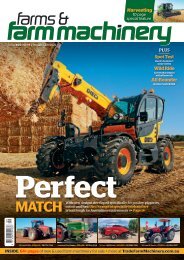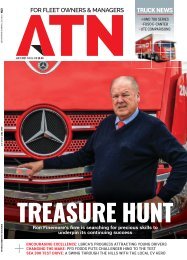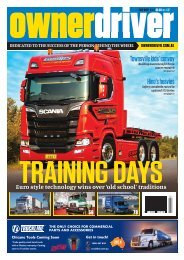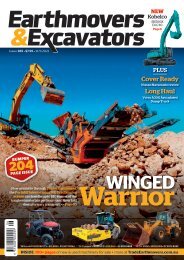Create successful ePaper yourself
Turn your PDF publications into a flip-book with our unique Google optimized e-Paper software.
HARVESTERS<br />
record yield<br />
The world record holder for<br />
the highest average wheat<br />
yield puts his success<br />
down to clever practices<br />
and smart machines<br />
Above: Eric Watson with his Case IH<br />
Axial-Flow 250 Series combine used in<br />
the record-breaking yield, and at the<br />
controls of the combine<br />
2020 has been a defining year so far – and there’s no<br />
exception in the world of wheat growing, with New Zealand<br />
farmer Eric Watson breaking his own Guinness World Record in<br />
February.<br />
Based in Wakanui, in Canterbury in New Zealand’s South Island,<br />
Watson achieved the world’s highest average wheat yield, of<br />
17.398 tonnes per hectare, harvested from 8.6353 ha at Paddock<br />
15a on his farm.<br />
Working with his wife Maxine, he set the previous record of<br />
16.791 tonnes with feed wheat in 2017 on the same paddock.<br />
Irrigated wheat yields in New Zealand average about 12 tonnes<br />
per hectare.<br />
Watson says part of the reason for his success was a series<br />
of productivity gains across multiple facets of his business,<br />
particularly through using tractor and combine harvest<br />
technology.<br />
He harvested the crop using a Case IH Axial-Flow 250 Series<br />
combine harvester, complete with the Case IH AFS Harvest<br />
Command software system, which uses sensors and optimised<br />
harvester settings to conserve grain and improve its quality.<br />
Sensors monitor air pressure on the sieves, warning<br />
of impending losses and allowing the combine to make<br />
adjustments before any grain is lost.<br />
“That new automation; it’s quicker than the human,” he says.<br />
“We always think we can beat computers, but you can’t beat<br />
that. The Harvest Command system knows what to do before<br />
you even see it on the screen.”<br />
Like many arable farmers, Watson says he uses tracked<br />
equipment to maintain soil quality.<br />
“I’ve stuck with tracks for years and I wouldn’t go away from<br />
them for cultivation because you get less compaction and you<br />
also get less slip,” he says.<br />
“With the Case IH Quadtrac you might run at 1 per cent but<br />
most of the time you’re running at zero. If you’re running a<br />
wheeled tractor at 10 per cent, if you’ve run 10 hours then<br />
you’ve lost an hour. And you’re also damaging soil structure by<br />
smearing it a bit.”<br />
Plus, Watson says: “If you’re using 80 litres of fuel an hour<br />
and you have to cultivate for an extra hour, well, that’s a lot of<br />
money.”<br />
This, plus other features including the Axial Flow mechanism<br />
in the harvester that reduces grain damage, goes a long way to<br />
ensuring impressive yields.<br />
Watson says he approached the 2020 Guinness record attempt<br />
in much the same fashion as his successful 2017 bid, albeit<br />
with a few key changes – born from working with Bayer’s New<br />
Zealand Crop Science team.<br />
To break the record, Watson switched wheat variety to feed<br />
grain Kerrin, bred by KWS, and used herbicides and fungicides<br />
from Bayer, as well as taking their agronomy advice.<br />
He also moved from solid urea to liquid, in order to improve<br />
spreading.<br />
“That played a big part as well, especially to get that extra<br />
600kg a hectare,” he says.<br />
“When you’re getting up to those high yield figures it’s hard to<br />
get a big figure like that.”<br />
Left: The CropScan sample head is<br />
mounted onto the clean grain elevator<br />
on a Case IH combine harvester<br />
cropscan<br />
secures<br />
supply deal<br />
Australian-made grain<br />
analyser provided direct from<br />
Case IH and New Holland<br />
dealers to customers under<br />
a new supply deal. Andrew<br />
Hobbs reports<br />
Australia’s Next Instruments will be able to supply its<br />
CropScan 3300H on-combine grain analyser direct to Case<br />
IH and New Holland customers after signing a supply deal with<br />
CNH Industrial.<br />
Under the new arrangement, dealers can arrange for Next to<br />
supply its CropScan 3300H to customers directly from its Sydney<br />
Factory.<br />
Case and New Holland dealers will also be able to access Next<br />
Instruments’ sales, technical and service support team directly,<br />
which Next says will ensure faster and better support for dealers<br />
and their customers.<br />
The deal follows an initial supply arrangement signed in 2016<br />
for the previous model, the 3000H, where Next supplied the<br />
analyser directly to CNHi for the company to install.<br />
Awarded Ag Innovation of the Year at the 2015 Wimmera Field<br />
Days, the system measures protein and moisture in wheat and<br />
barley; and oil, protein and moisture in canola.<br />
Next Instruments chief executive Phil Clancy says early signs<br />
from dealers are promising, and the company has built up<br />
inventory stocks in anticipation of higher demand.<br />
Launched for harvest last year, the new CropScan 3300H has<br />
a number of added features, including a new sample head that<br />
increases the grain flow rate and reduces scan time to 5–10<br />
seconds per measurement.<br />
The other improvements are a lighter tablet PC controller,<br />
better weigh scale communications and a cloud account and<br />
portal for the uploading of data mapped by the analyser.<br />
Retrofittable and used on all major harvester brands, the<br />
analyser affixes to a harvester’s clean grain elevator, taking<br />
samples and analysing them every time the sampling head<br />
is full.<br />
“That then gets presented to the grower on the screen and it<br />
gives him a moving average, then he can choose a number of<br />
different displays to have a real time field map,” Clancy says.<br />
Next Instruments is also working on new ways to help farmers<br />
use the data, through a new entity called CropScan Ag Solutions.<br />
“It is quite complex to use the software to develop all the field<br />
maps, so in some cases it has not gone any further,” he says.<br />
“So we are developing a system where we take the data, put<br />
it into the cloud, convert it to field maps and then post that<br />
directly to the farmer and their agronomist.”<br />
48 Trade<strong>Farm</strong><strong>Machinery</strong>.com.au THE TRACTOR YOU WANT IS NOW EASIER TO FIND

















